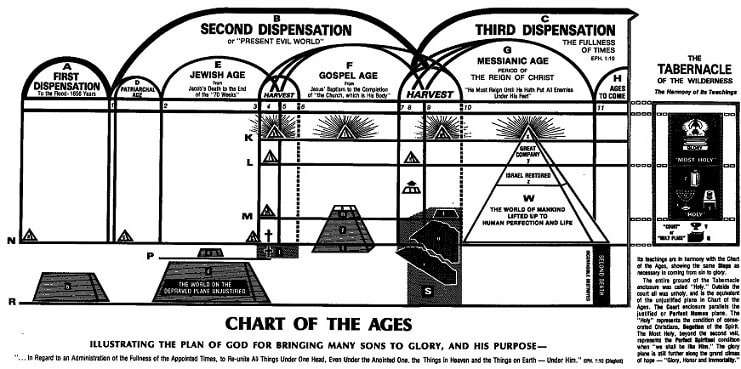Russell’s chronological error of 100 years
Beginning on page 631, Jehovah’s Witnesses — Proclaimers Of God’s Kingdom discusses a bit of the development of the chronological framework used by C. T. Russell. Of course, nearly all this framework has been abandoned because later research showed it was quite unscriptural even at the time it was first written down. In an effort to soften how unscriptural this chronological speculation actually was, and to give the impression that it was in fact scriptural, the book says, with reference to the Bible Students’ hopes and expectations for when many of their beliefs would be fulfilled:
It was only natural that they should wonder when and how these things would occur. Did the inspired Scriptures provide any clues?
Using Bible chronology that had first been laid out by Christopher Bowen of England, they thought that 6,000 years of human history had ended in 1873, that thereafter they were in the seventh thousand-year period of human history, and that they had surely approached the dawn of the foretold Millennium. The series of books known as Millennial Dawn (and later called Studies In The Scriptures), which were penned by C. T. Russell, drew attention to the implications of this according to what the Bible Students understood from the Scriptures.
Note that the Proclaimers book calls Bowen’s chronology Bible chronology. That is like calling belief in hellfire a Bible doctrine.
Something else that was seen as a possible time indicator involved the arrangement that God instituted in ancient Israel for a Jubilee, a year of release, every 50th year. This came after a series of seven 7-year periods, each of which ended with a sabbath year. During the Jubilee year, Hebrew slaves were freed and hereditary land possessions that had been sold were restored. (Lev. 25:8-10) Calculations based on this cycle of years led to the conclusion that perhaps a greater Jubilee for all the earth had begun in the autumn of 1874, that evidently the Lord had returned in that year and was invisibly present, and that “the times of restitution of all things” had arrived. — Acts 3:19-21, KJV.
Next are discussed other aspects of Russell’s chronology, such as his claim that the resurrection had begun in 1878. Finally, a different understanding of the Jubilee cycles is discussed. This became the basis for Rutherford’s failed prediction of 1925 as “the end of the world.”
On pages 632-3, the Proclaimers book continues:
Later on, during the years from 1935 through 1944, a review of the overall framework of Bible chronology revealed that a poor translation of Acts 13:19, 20 in the King James Version,* along with certain other factors, had thrown off the chronology by over a century.#
The footnotes read:
* Compare the rendering in The Emphasised Bible, translated by J. B. Rotherham; see also the footnote on Acts 13:20 in the New World Translation of the Holy Scriptures — With References.
# See The Truth Shall Make You Free, chapter XI; The Kingdom Is At Hand, pages 171-5; also The Golden Age, March 27, 1935, pages 391, 412. In the light of these corrected tables of Bible chronology, it could be seen that previous use of the dates 1873 and 1878, as well as related dates derived from these on the basis of parallels with first-century events, were based on mis-understandings.
As is usual in the Proclaimers book, just enough information is given the reader to form a dim picture of the real situation. The things that were done are described with passive tense verbs, and the people who did them are not mentioned. This casts a comfortable anonymity over the proceedings and isolates those responsible from what they did. Everything is seen through a veil of obscurantism.
The last paragraph quoted above gives the impression that the chronology used by Russell and the Bible Students was thrown off by a factor not under their control, namely, the poor translation of Acts 13:19, 20 in the KJV. See also p. 133, footnote*. But this factor was only a problem for Christopher Bowen, not for anyone with access to newer Bible translations based on ancient Greek texts that were just coming to light. For example, the Emphatic Diaglott, first published in completed form in 1864, had a marginal note showing the alternate rendering from the “Vatican Manuscript,” which was not available to the KJV translators but is the basis for the Society’s New World Translation. This alternate rendering was part of the basis for the Society’s changes to chronology from 1935 through 1946. It came to light as early as 1775, when the first of J. J. Griesbach’s Greek texts became available. This text was the basis for the Diaglott. The Diaglott was well known, of course, to N. H. Barbour and C. T. Russell, since its rendering of the Greek parousia as “presence” was the basis for their doctrine of the “invisible presence” of Christ. They knew this translation very well.
Was the Emphatic Diaglott the only translation that indicated an alternate rendering for Acts 13:19, 20? Not at all. After the mid-19th century many translations became available using the latest Greek texts. The well-known text of Westcott and Hort, today’s standard, became available in 1881, although others were available much earlier. The English Revised Bible, using the latest Greek texts, was available by 1885, and many other Bibles using the latest texts became available by about 1900. The American Standard Version, a revision of the English Revised Bible, was published in 1901. According to the Proclaimers book (pp. 605-6) the Society was distributing a variety of Bibles by 1896, of which the following used the latest Greek texts to render Acts 13:19, 20: Tischendorf’s New Testament, the Variorum Bible, Rotherham’s translation, the Holman Linear Parallel Edition containing the English Revised Version, and the Emphatic Diaglott.
So while Christopher Bowen might be excused for publishing an incorrect chronology, there was no such excuse for N. H. Barbour in the early 1870s, and certainly not for the Watchtower Society after 1900. It is quite evident that the only reason the chronology was retained in spite of the availability of correct translations is that it had already become well established doctrine and was seen by Russell as divinely inspired. Concerning these dates, Zion’s Watch Tower, July 15, 1894, said on page 226, under the subtitle “Can It Be Delayed Until 1914?”:
“We see no reason for changing the figures — nor could we change them if we would. They are, we believe, God’s dates, not ours.”
The footnote marked with a * above inadvertently admits that this information was known early on. The footnote marked with a # refers to several other references. Interestingly, chapter XI of The Truth Shall Make You Free (1943) quotes Acts 13:19, 20 from the American Standard Version and makes no references to any changes of understanding from earlier publications or from the KJV or from the Diaglott. Nor does the reference in The Kingdom Is At Hand (1944) explain these things. It only states the results as a given.
Apparently it was left for the 1973 book God’s Kingdom of a Thousand Years Has Approached to explain what was done. Chapter 11 contains an explanation of the reasoning behind the presentation in the earlier books. The book gives an explanation on pages 206-11, which will not be reproduced here. Let it suffice to say that a discrepancy of 100 years is evident between the 450 year period of the Judges implied by the KJV and Diaglott renderings of Acts 13:19, 20 and the 350 years calculated in the discussion in paragraph 51. The Proclaimers book says that the discrepancy was due to a poor translation of this scripture in the KJV, but God’s Kingdom Of A Thousand Years expressly states that the error was due to following the suggestion of a footnote in The Emphatic Diaglott. Paragraph 52 does mention the KJV as being in agreement with the Diaglott, but the impression is that the argument in the Diaglott was the deciding factor. So the book clearly admits that there were factors that could have caused a correct chronology to be ascertained, if only proper account was taken of all the relevant information. It must be asked, Since the correct information was available to N. H. Barbour and C. T. Russell, why did God’s spirit not direct them to a correct understanding? Did God really want the correct understanding to be hidden for some 70 years, until 1943?
The God’s Kingdom book also only speaks of C. T. Russell as having made these calculations. No mention is made of N. H. Barbour or Christopher Bowen or any other socalled Bible chronologers of the time. This is another example of the Society’s past practice of attempting to credit Russell with originating all of his teachings, rather than attributing them to various Adventist and other sources. The Watchtower Society is to be commended for rectifying this in the Proclaimers book.
Continuing with our discussion of the presentation in the Proclaimers book, a serious omission is that it does not tell the reader about the alternate rendering for Acts 13:19, 20 mentioned in the Diaglott, as discussed above. Instead, the KJV is blamed for the error. This alternate rendering, if followed, would have required all of Barbour and Russell’s chronology to be shifted forward by 100 years. Christ’s presence would have to begin in 1974, not 1874. Of course, this was not a desirable result, and so rather than honestly evaluating both renderings, which were available in The Diaglott, they used the incorrect but comforting rendering of Acts 13 as a basis for their calculations.
This discussion brings up another problem with the God’s Kingdom book. It says that the error in the calculation of the start of Christ’s presence was due to faulty information in the Diaglott. However, the difference between 1874 and 1914 is 40 years, not 100. The book, in paragraph 55, sidesteps the explanation of how 1874 was moved to 1914 as the start of Christ’s presence. Rather than explaining how the 100 year discrepancy fits in, it merely says:
In the year 1943 the Watch Tower Bible and Tract Society published the book The Truth Shall Make You Free. In its chapter 11, entitled “The Count of Time,” it did away with the insertion of 100 years into the period of the Judges…. Naturally this did away with the year 1874 C.E. as the date of return of the Lord Jesus Christ and the beginning of his invisible presence or parousia…. What, then, about the parousia (presence) of Christ? Page 324 of the above book positively says: “The King’s presence or parousia began in 1914.” Also, in the Watchtower… the statement is made: “… Messiah, the Son of man, came into Kingdom power A.D. 1914 and… this constitutes his second coming and the beginning of his second parousia or presence.”
So, with a wave of the pen — “the book positively says….” — the author of God’s Kingdom evades a difficult explanation. This is reminiscent of a similar evasion in the 1944 book The Kingdom Is At Hand. On page 171 it stated that The Truth Shall Make You Free explained how the Society changed the date of Jerusalem’s destruction from the summer of 606 B.C. to 607 B.C. But the latter book did no such thing, and so the Society never actually gave a reason for the change, although it claimed it did. The same kind of thing was done in changing the date for the beginning of the prophecy of 69 weeks for the Messiah from 454 to 455 B.C.E. in the mid-1940s.
Our discussion brings up some other interesting points. Paragraph 49 of the God’s Kingdom book makes a number of unstated assumptions that have all proved unfounded. While the Bible nowhere states it, the book assumes that Russell’s assigning 7000 years to a “magic” time period is correct. In other words, it assumes that there are precisely seven millennia in a creative “week.” This notion can be traced back to Jewish rabbinical thought. Russell himself knew this was only an assumption, but his successors seem to have forgotten it. He wrote in The Time Is At Hand, p. 39:
Though the Bible contains no direct statement that the seventh thousand will be the epoch of Christ’s reign, the great Sabbath Day of restitution to the world, yet the venerable tradition is not without a reasonable foundation.
The Society applied this “venerable tradition” to its 1975 prediction, and the failure is known to all students of religion.
A little thought shows how unreasonable this assumption is. When God created the earth, “all the sons of God began shouting in applause” (Job 38:7). So angels were on hand when God created man, and they knew the exact date this occurred. Therefore, if the 7th millennium corresponded to Christ’s reign the angels would have known when it would start, and also the start of Armageddon and “that day and hour” of Matthew 24:36. But because Matt. 24:36 says that “concerning that day and hour nobody knows, neither the angels of the heavens nor the Son, but only the Father,” there can be no correspondencebetween the 1000 year reign and the 7th 1000 year period of human history.
It should be clear that the Society’s publications, even the new history book that was billed in the public talk releasing it as a candid look at the history of Jehovah’s Witnesses, do not give a complete picture of the many chronological calculations it has advanced over the years.


